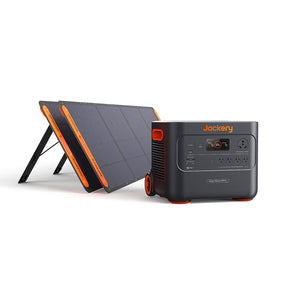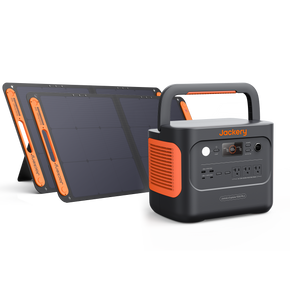Solar Panel Lifespan: How Long Do Solar Panels Last
Solar panels are a lasting source of clean energy for you and your family. It can help you save energy and power appliances. If you plan to offset your electricity usage and reduce your bills with a solar power generator, it's vital to know how long do solar panels last and when you'll need to replace your system after deterioration.
Generally, the lifespan of a solar panel is between 25-30 years, depending on the usage, manufacturer, location, etc. However, that does not mean the solar panels will die after 25-30 years. Instead, the power output will decrease by a significant amount after years.

Jackery portable solar panels have the highest 25% efficiency in the industry. Together with Jackery rechargeable portable power stations, the cost-effective solar power solution can help you with clean energy for decades. This Jackery article will reveal everything related to solar panel lifespan and how power station systems can help you save money.
How Long Do Solar Panels Last?
Most residential solar panels operate between 25-30 years before they start to degrade (or produce less energy). If well-maintained, the solar panel lifespan ranges between 40-50 years without any trouble.
However, the exact lifespan of solar panels differs depending on their type, manufacturer, and other crucial external factors. Below we have mentioned the three main types of solar panels and their expected lifespan.
Monocrystalline Solar Panels
Monocrystalline silicon panels are the most efficient panels that help utilize sustainable solar energy. They have higher purity than poly-crystalline silicon panels and undergo more complex manufacturing processes. As they are made from one pure crystal, the lifespan of solar panels is between 25-50 years. All Jackery solar panels are made with monocrystalline solar cells, and equipped with adjustable stands, the conversion efficiency can be up to 23%-25%. Make the most use of the solar power.

Poly-Crystalline Solar Panels
Unlike mono-crystalline solar panels, poly-crystalline cells are less efficient and less expensive. The crystallinity of the silicon in each unit is less, making it a less expensive solution. As the electric forces tend to separate the crystal, poly-crystalline solar panels last only 25 years.
Thin-Film Solar Panels
Solar panels are formed by depositing one or more thin layers of photovoltaic material. It is made up of thin-film solar cells. However, it is less preferable compared to mono-crystalline and poly-crystalline solar panels. Thin-film solar panels last anywhere between 10-20 years.
Remember, solar panels continue to convert sunlight into solar energy after 25-50 years of their lifespan — just at a lesser efficiency.
What Affects the Solar Panels Lifespan?
External factors, such as panel quality, climate, and maintenance, affect the solar panel lifespan beyond your control. Let us discuss the common aspects in detail here:
Quality
The quality of solar panels can significantly impact energy output and power generation capabilities. The material used in manufacturing solar panels and their types will affect how long they'll last and how well they work in extreme conditions. Even though low-quality materials make solar panels affordable, their long-term benefits are less. That said, you should choose the mono-crystalline solar panel made using quality silicon that allows you to enjoy unlimited power for decades.
Climate
Extreme weather conditions, like heavy rainfall, snow, hail, cold waves, etc., can reduce the lifespan of solar panels. Just like cold temperatures, heat can lead to cracks in solar panel frames, lowering the amount of electricity output. Homeowners wanting to extend their solar panel lifespan should focus on purchasing high-quality solar panels from a reputable company.
Maintenance
Like any other product, solar panels last longer when they are well-maintained. However, continuous exposure to dirt and debris can degrade the efficiency of solar panels by blocking access to the sun. Therefore, it is best to wipe off the dust and debris that accumulate on the solar panel regularly. In addition, catching the issues early on will reduce the extent of damage caused to solar panels over time.
Proper maintenance of solar panels will help you get the maximum benefits from purchasing a portable power station.
What is Solar Panels Degradation?

Over time, solar panels show a reduced ability to absorb sun rays and convert them into energy due to hot weather, extreme cold waves, or fluctuating chemical potency within the cells.
The reduced ability/efficiency of solar power panels to generate electricity is what we refer to as the degradation rate.
The solar panel with a low degradation rate will produce more energy over its lifespan. It can range from 0.3% to 1.0% of a solar panel's efficiency.
Here is a simple example to help you understand better:
Let's say you have installed a solar panel with initial output of 10,000 KWh annually. Suppose the solar panel degradation rate is 0.50% each year. Here is how you can calculate the output after years.
After the first year:
- Initial output = 10,000 KWh
- Lost output = 10,000 KWh x 0.005 = 50 KWh
- Remaining output = Initial output – Lost output = 10,000 KWh – 50 KWh = 9,950 KWh
The cycle continues, and your solar panel loses 0.5% in the second year. You can calculate the output similarly.
- Initial output = 9,950 KWh
- Lost output = 9,950 KWh x 0.005 = 49.8 KWh
- Remaining output = Initial output – Lost output = 9,950 KWh – 49.8 KWh = 9,900 KWh
Similarly, you can calculate the degradation rate of solar panels after 25 years. Remember, this was a general estimation of degradation.
Sometimes, the degradation rate can increase depending on external factors like weather, maintenance, etc. Besides external factors, the degradation rate depends on internal factors such as panel type.
Below we have illustrated how panel type affects the amount of output after years.
|
Type of Panel |
Degradation Rate |
Reduction Over 25 Years |
Original Output After 25 Years |
|
Tier 1 |
0.3% |
6.96% |
93.04% |
|
Tier 2 |
0.5% |
11.33% |
88.67% |
|
Tier 3 |
0.8% |
17.53% |
82.47% |
Tier 1 panels have a lower degradation rate than other panel types. That said, homeowners wanting to choose solar panels that offer a high return on investment should choose Tier 1 or Tier 2 solar panels.
What Causes Solar Panel Degradation?
When the efficiency of silicon solar cells reduces, it leads to lower electricity production and solar panel degradation. The primary causes of solar panel deterioration include the following:
Thermal Cycling
Due to the change in temperature between day and night, the silicon materials expand and contract naturally to form microcracks. When the temperature is high, the material inside the cells expands. On the other hand, the materials contract when the temperature falls. Over time, excessive exposure to heat and cold alternatively makes the seal around the solar panel brittle and leads to cracks. Jackery solar panels are designed with the battery grid structure on the backside to avoid cell cracks.
Strong Winds
Severe cold or hot winds for a long time can cause the flexing of solar panels — also referred to as dynamic mechanical load. Extreme hot weather, cold waves, snow, ice, and humidity could majorly contribute to solar panel degradation.
UV Rays
Some areas receive relatively high sunshine hours that degrade the upper layer of solar panels. Therefore, it's best to consider choosing advanced solar panels with UV blockers. The built-in UV blockers will reduce the damage caused by the sun to the solar panel cells, improving the lifespan of the solar panels.
Just because the solar panel has reached the end of its expected life doesn't mean it can't produce energy. The solar panels will continue to supply electricity after deterioration but at a lower efficiency level.
Jackery SolarSaga Solar Panels are designed to last for years, ensuring a consistent power supply for decades. Unlike traditional solar panels, Jackery solar panels are portable and can be carried around as needed. This means you don't have to keep the solar panels in sunlight when there is no sun, and they can be used as per needs.
In addition, it makes the new technology convenient for home usage and outdoor activities like camping. Furthermore, solar panels require very low maintenance. The only maintenance needed to improve the efficiency of solar panels is cleaning the outer surface with a cloth.
How Fast Do Solar Panels Degrade?
According to the research conducted by the National Renewable Energy Laboratory (NREL) in 2012, solar panel output fell by 0.8% each year. On average, solar panels degrade faster at a rate of 1% each year. Though the metrics will vary from one panel to another depending on the brand and the solar panel placement.
The components in your solar power system are prone to wear-outs and require regular maintenance and replacement. Some crucial parts of solar panels that can degrade include wiring, racking, inventors, and other add-ons, including solar battery storage.
How to Extend Solar Panel Lifespan?

Now that you know how long do solar panels last, it's time to understand how to extend their lifespan. Proper solar panel maintenance will ensure the solar power station works efficiently for decades.
Following a few simple tips will not only extend the lifespan of your solar panel but will also ensure that it produces an appropriate amount of electricity and saves money.
Keep The Panel Clean
Often, the accumulation of leaves, dirt, debris, etc., can affect the efficiency and lifespan of solar panels. That's why it's essential to clean the panels monthly using a clean cloth.
If your home area is prone to extreme weather conditions like strong winds, hail, or snow, it's best to clean the panels weekly. Most residential solar panels available on the market are easy to clean and last for more than 25 years without showing any signs of damage.
Maintain Backup Battery(Portable Power Station)
Batteries in solar power systems play an essential role in determining the lifespan of solar panels. Lithium-ion batteries store the energy received from the solar panel and supply it to the appliances so you can charge up your gears.
But how long do solar panel batteries last? Depending on the specific battery brand, the manufacturer's warranty lasts between three to ten years. You can extend the lifespan of a solar power system with proper maintenance and upkeep of the battery.
Professional Inspection
Many homeowners often neglect professional inspection of the solar system. If electricity production is reduced, it's best to call professionals to identify the potential issues at first glance.
Once-a-year inspection will help ensure that the solar system operates at peak performance. When you purchase Jackery solar power panels, you get quick support from professionals.
Jackery Solar Panel Warranty
Solar panels come with a few different warranties that help you identify the expected solar panel lifespan and evaluate the cost of solar panels. The manufacturer's warranty includes protection against manufacturing defects, performance warranty, equipment warranty, etc.
Jackery offers different portable solar panels with high efficiency and long lifespan. You can keep your gear charged during camping or at home by teaming it up with a Jackery power station. In addition, it can be an excellent power backup solution during power outages or blackouts.

Here's a breakdown of the three Jackery solar panels with their features:
|
Solar Panels |
Weight |
Material |
Conversion Efficiency |
Compatibility to which portable power station |
Specialty |
|
Jackery SolarSaga 200W Solar Panel |
17.5±0.5 lbs |
Mono-crystalline silicon |
24.3% |
Jackery Explorer 2000 Pro and 1000 Pro |
|
|
Jackery SolarSaga 100W Solar Panel |
10.33 lbs |
Mono-crystalline silicon |
23% |
Jackery Explorer 240/500/1000 power station. |
|
|
Jackery SolarSaga 80W Solar Panel |
11.2 lbs |
PET material |
25% |
All the Jackery power stations. |
|
All three solar panels are durable, easy to use, and highly efficient. You can use solar panels at home or outdoors and reap the benefits of clean electricity.
When Should You Replace Your Solar Panels?
Older models generally degrade faster than current solar power generators. That said, you'll need to figure out the model and age of the solar panel before replacement.
Physical trackers and apps can help monitor how much electricity the solar panels generate. In addition, technology can help you determine the solar panel degradation rate and identify when it's time for a replacement.
Keep in mind that if your solar panel generates less power than it initially was, it doesn't mean you need to replace it. Instead, start saving and ensure you can quickly get new solar panels.
In a nutshell: if your solar panels produce enough electricity for your off-grid living, RV living, and to recharge your portable power station in a standard time, you don't have to consider a replacement. But, if you're drawing a lot of power from the grid, it's probably time to consider a solar installer and upgrade the system.
FAQs About Solar Panel Lifespan
1. What will happen to solar panels after their useful lives are over?
End-of-life management refers to the processes performed after solar power panels and all the elements retire from the operation. The estimated operational lifespan of solar panels or photovoltaic modules is about 30-35 years. Once the useful lives are over, the waste produced requires maintenance and adequate disposal.
According to the International Renewable Energy Agency report, an estimated 4500 GW of solar energy could be installed worldwide by 2025. That said, once the end-to-life stage is reached, the volume of scrap will increase, which requires attention.
2. Should you replace your solar panels after 25 or 30 years?
Solar panels will convert sunlight to solar energy and then electrical power even after 25 or 30 years.
However, it won't produce the same amount of electricity as it initially was due to solar panel degradation.
Consider replacement of solar panel if:
- The solar panel is not producing enough energy to meet your electricity needs.
- One or more solar panels are broken or cracked.
But you don't have to replace solar panels if:
- Solar panels produce electricity that meets your home'sor outdoor activities power needs.
- No solar panel is cracked or broken.
3. What is the carbon footprint of solar panels?
Solar power panels emit nearly 50g of CO2 per KWh in the initial few years of operation. Solar power is a much cleaner alternative to coal as the former produces 20 times less carbon output than the latter. You can switch to a solar power station if you want a clean energy source to power your appliances. By the third year of using solar panels, most solar panels become carbon neutral.
Best Portable Solar Panels
Jackery portable solar panels are foldable and portable, which makes them easy to carry and use. It has the highest conversion efficiency of 25%, uses the most sunlight, and converts it into clean energy. In addition, you can pair this monocrystalline solar panels with the Jackery explorer power station to set up your solar power system.
The portable, battery-powered power station is a safe, rechargeable, and easy-to-use power backup source. It has a battery management system that protects the generator from overcharging, over-discharging, over-voltage, over-current, etc.
Solar panels create an unbeatable portable solar generator when combined with explorer power stations. With the power solution, you can charge anything from the refrigerator, heater, mini cooler, electric stove, etc., and save dollars.

Final Thoughts
Understanding how long do solar panels last will help you cut down connections from the electricity grid for decades and use renewable energy to power appliances. An eco-friendly power supply solution is an invaluable addition to your home.
Jackery SolarSaga solar panel is a versatile power backup solution that helps you meet all your energy needs. Buying the right solar power panel that lasts for a long time is the only way to save money on your electricity bills.
You can team up the Jackery SolarSaga solar panels with the Jackery portable power station to enjoy the sustainable power solutions that supply electricity to power your complete home.
Whether you're buying a solar panel for the first time or want to replace your old panels with new ones, Jackery is an incredible resource in both cases. For more information, sign up for Jackery's newsletter to receive exclusive deals, discounts, news, and product releases!
















































































































































Leave a comment